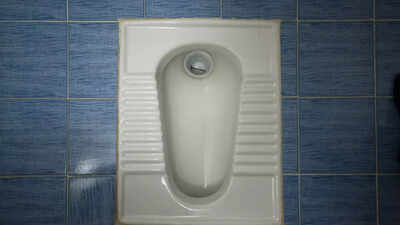ARTICLE AD BOX

Rediscovering traditional Indian toilet systems, especially the squat-style toilets once common in households, reveals more than just cultural heritage. They may actually support digestive health and overall well-being.
While modern India has largely shifted toward Western-style sitting toilets, medical research suggests that squatting aligns the body in a more natural position. This posture relaxes the puborectalis muscle, straightens the anorectal angle, and allows smoother bowel movements, reducing the need to strain. In contrast, sitting toilets often create a sharp 90-degree angle, which can make evacuation incomplete and lead to issues like constipation and haemorrhoids.Importantly, these claims are not just anecdotal. A study by Chakrabarti and colleagues published in The National Medical Journal of India found that 36 percent of stroke cases in India occurred while squatting in toilets, showing both the physiological impact and the risks of this posture. Their findings recorded spikes of 14 mmHg in systolic and 9 mmHg in diastolic blood pressure among hypertensive subjects during squatting.This article explores the science, benefits, and risks of Indian squatting toilets compared with sitting toilets, balancing cultural wisdom with modern health insights.
Squatting toilets vs sitting toilets and the anatomy of posture
The human body is designed in ways that link posture directly with bowel function. When you squat, the thighs press against the abdomen and straighten the anorectal angle. This reduces resistance and allows stools to pass more freely. Sitting, however, keeps the rectum bent at around 90 degrees, which forces the body to exert more pressure to push stools out. Over time, this additional strain can contribute to constipation, haemorrhoids, and even pelvic floor disorders.
Comparative studies show that people who squat report shorter defecation times and less straining, proving the physiological benefits of the squat position.
Squatting toilets in India and their digestive health benefits
Traditional Indian squatting toilets are often praised for lowering the risk of constipation and straining-related problems. Squatting creates an easier flow path, reducing pressure inside the colon. This can help prevent haemorrhoids, which develop when veins in the rectum swell due to repeated straining.
Squatting is also linked to fewer urinary tract infections in women, since the position promotes more complete bladder emptying.Beyond personal health, squatting toilets are more hygienic in many cases. They require less direct contact with surfaces, making them safer in public places. They also use less water compared to flush-based sitting systems, which is an important advantage in a country facing water scarcity.
Squatting toilets and the risks for cardiovascular and joint health
While squatting toilets offer clear digestive benefits, they are not free from risks. The Chakrabarti study highlights a major cardiovascular concern. Squatting can cause significant spikes in blood pressure, which is dangerous for people with hypertension or heart disease. Their data showed that more than a third of stroke cases in India were linked to squatting toilets.There are also musculoskeletal risks. Elderly people or those with limited mobility may find squatting painful or unsafe, which increases the risk of falls or injuries.
Doctors have also noted ankle and tendon injuries associated with squat toilets. For these groups, using a sitting toilet or a hybrid solution may be safer.
Indian toilets and public health progress under sanitation programs
The debate over squatting toilets and sitting toilets is tied closely to sanitation policy in India. The Swachh Bharat Mission has built millions of toilets nationwide, drastically reducing open defecation. Studies show that improved sanitation is linked to lower diarrhoeal diseases and better child health.
However, urban areas under these programs have favoured sitting toilets, reflecting lifestyle aspirations rather than medical science.Most public health messaging focuses on hygiene and access, which are vital priorities. But the effect of toilet posture on health rarely enters the discussion. Raising awareness on this aspect could make sanitation programs more holistic.
Adaptive solutions for Indian squatting toilets and sitting toilets
For people who prefer sitting toilets but want the digestive benefits of squatting, hybrid solutions exist.
Simple tools like footstools can mimic the squatting angle while using a Western toilet. Some modern designs also offer convertible toilets that allow both squatting and sitting.For older adults or hypertensive patients, sitting toilets with supportive devices may be the safest compromise. This approach balances digestive benefits with cardiovascular safety.
Cultural and behavioural habits around toilets in India
Toilet habits are deeply shaped by culture in India. Older generations are more comfortable with squatting, while younger people associate sitting toilets with modern lifestyles.
Behavioural studies show that social norms strongly influence toilet preferences. For example, sanitation drives in rural India worked best in communities where people saw neighbours adopting toilets, creating a ripple effect.Understanding these cultural habits is essential when promoting health messages about toilet posture. Linking medical evidence with cultural acceptance is the best way forward.Traditional Indian squatting toilets clearly offer digestive health advantages by aligning the body naturally.
However, research warns of cardiovascular risks for people with hypertension, along with mobility concerns for the elderly. Adaptive solutions such as footstools or hybrid toilets may provide the best of both worlds.The key takeaway is awareness: how we sit or squat can directly affect our digestion, heart health, and long-term well-being. In a country that is rapidly urbanising, balancing traditional practices with modern safety is the way to move forward.Disclaimer: This article is for general informational purposes only and is not a substitute for professional medical advice, diagnosis, or treatment. Always seek the guidance of a qualified healthcare provider regarding any medical condition or lifestyle change.Also read|Early signs of dementia: How difficulty reading faces can indicate cognitive decline



.png)
.png)
.png)
















 5 hours ago
4
5 hours ago
4







 English (US) ·
English (US) ·